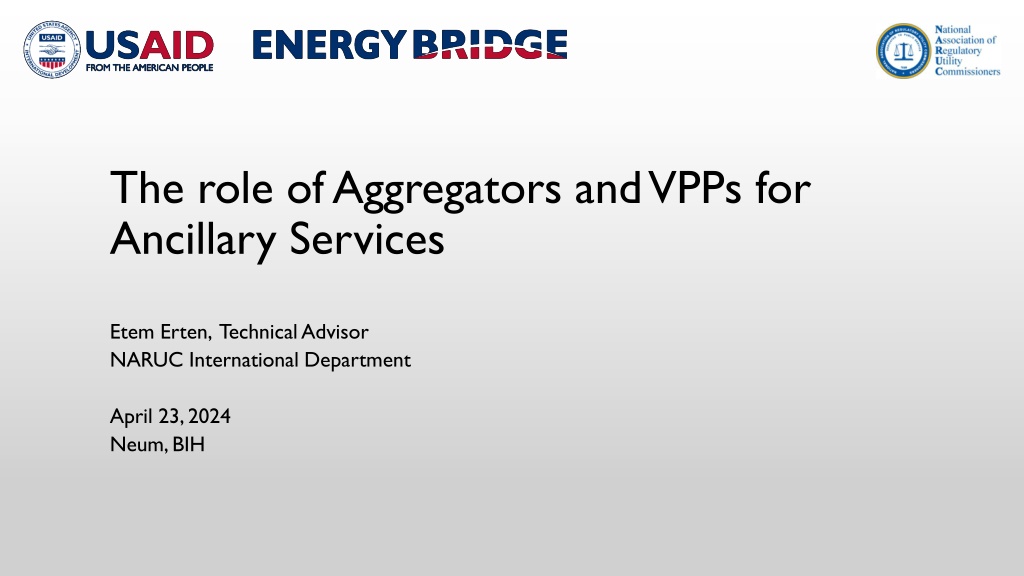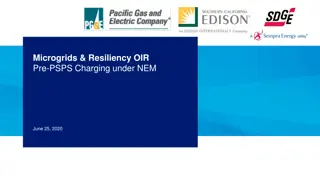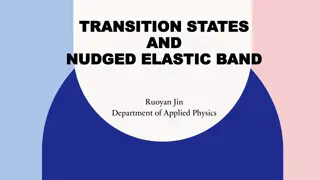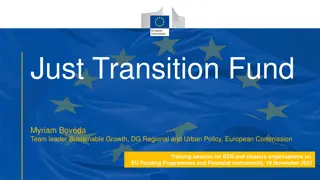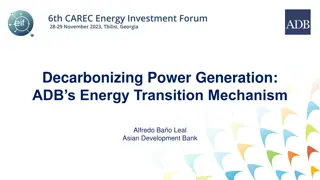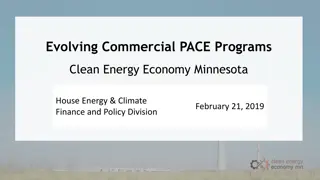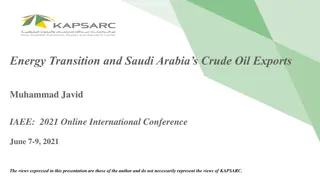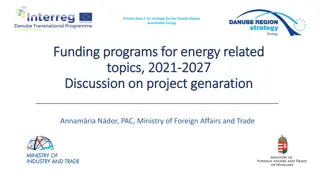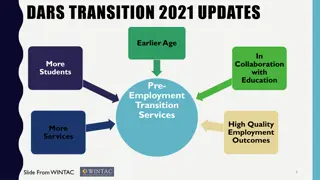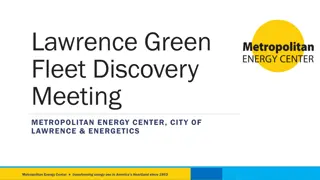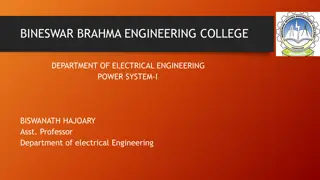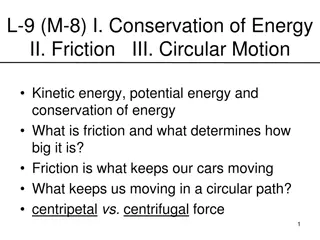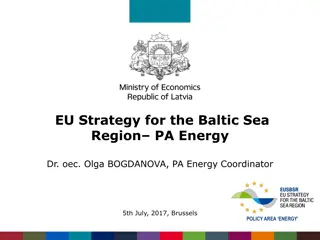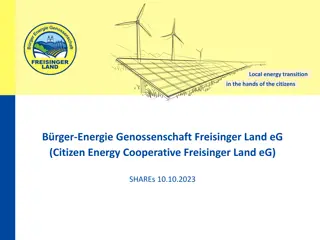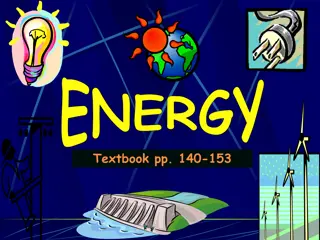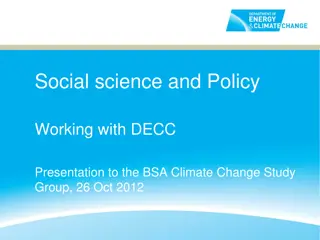The Evolving Role of Aggregators and VPPs in the Energy Transition
The presentation delves into the significant shifts in the energy industry towards sustainable sources and decentralization. It explores the emergence of Virtual Power Plants (VPPs) and the aggregation of Distributed Energy Resources (DERs) to provide ancillary services, addressing the challenges and opportunities in the evolving landscape of energy production and consumption.
Uploaded on Sep 17, 2024 | 0 Views
Download Presentation

Please find below an Image/Link to download the presentation.
The content on the website is provided AS IS for your information and personal use only. It may not be sold, licensed, or shared on other websites without obtaining consent from the author. Download presentation by click this link. If you encounter any issues during the download, it is possible that the publisher has removed the file from their server.
E N D
Presentation Transcript
The role of Aggregators and VPPs for Ancillary Services Etem Erten, Technical Advisor NARUC International Department April 23, 2024 Neum, BIH
Presentation Outline The larger context electric industry transition Drivers and impacts of DER growth Aggregation of DER into virtual resources (VPPs) Role of VPPs in providing ancillary services Best practices on New flexibility products
Major Transformation characterized by: Transitioning from traditional fossil fuels to sustainable but intermittent energy sources across all levels. A surge in the integration of a wide array of decentralized energy options (e.g., energy communities, microgrids, off grid homes) Electrification of transportation, heating, and other large energy uses Decline of the traditional centralized, one-way power flow paradigm and associated revenue models and rate structures New operational challenges to manage high DER penetration (especially DSOs)
DER growth is driven by: Governments adopt climate action plans, seek to boost local economy, extend renewable energy and electrification Development in new technologies and innovations make DERs feasible & economic Customers want clean and low-cost energy, and resilience to disturbances EU energy crises and high prices made renewables more attractive
EU Energy Crisis Other Implications Going Forward:
Role of Electrification Expected demand growth for UK Source: Modo Energy - How local flexibility markets for electricity work
The New Paradigm Long Term Bottom-up autonomous adoption => less top-down control Potential for low-cost, resilient islanding; possible grid defection Potential for transactive peer-to-peer markets at the grid edge Flexibility products IN, pure kWhs OUT
Terminology DER = all energy resources connected at distribution level, on customer side or utility side of the customer meter. A Virtual Power Plant (VPP) is a virtual system asset that aggregates the capacities of various distributed energy resources (like wind turbines, solar panels, energy storage systems, and DR) and operates them as a single power plant.
Terminology Directive (EU) 2019/944 defines aggregation and 'independent aggregator as, respectively: a function performed by a natural or legal person who combines multiple customer loads or generated electricity for sale, purchase or auction in any electricity market; a market participant engaged in aggregation who is not affiliated to the customer's supplier.
DER: devices capable of producing power and connected to the distribution system or behind a customer meter. E.g.: WHOLESALE Rooftop and small utility solar, combined heat and power, small hydro, non-wires alternatives, peak shavers & back-up units WIRED WITH LOAD DR FTM NON WHOLESALE For PJM: excludes load reduction and energy efficiency WHOLESALE participates in wholesale markets. E.g.: EXCESS Small dedicated solar, landfill gas, and batteries SELL Wholesale demand response WIRED WITH LOAD DER wired with load behind a load meter (commonly referred to as behind the meter ). FTM Front of meter gen and storage: DER studied for injections by PJM and sells injections into wholesale market. DR PJM Demand Response from DER: offsets in load at a customer from generators and batteries that are wired with load. Non-wholesale DER w/ no explicit participation in wholesale markets. PURPA SELL EXCESS DER wired w/ load selling excess energy at wholesale. PURPA DER selling outputdirectly to interconnected utility under state- administered avoided-cost rate. No interaction with PJM. DER -- What are we talking about? www.pjm.com
Challenges and opportunities New challenges for distribution operations, planning & interconnection Multi-directional, reversible flows on the distribution system Substantial local supply to meet local demand Long interconnection queues Congestion at the distribution level DER is in a position to not only provide services to customers, but also the networks (DSO and TSO systems)
DERs target revenues at multiple levels of the system. Transmission system & wholesale market DAM and IDM, balancing market, ancillary services market Resource adequacy capacity (capacity markets or remuneration mechanisms) Non-wires alternatives to transmission upgrades Distribution system services Deferral of new infrastructure (non-wires alternatives) Operational services voltage, power quality Behind the end-use customer meter Time of day load shifting, demand charge management, storage of excess solar generation Service resilience smart buildings, microgrids, critical loads Bilateral energy contracts with customers Citizen and Renewable energy communities
DER developers/adopters seek to provide services and earn revenues at multiple levels of the system. DER = all energy resources connected at distribution level, on customer side or utility side of the customer meter Plus communications & controls to aggregate & optimize DER Behind the end-use customer meter Time of day load shifting, demand charge management, storage of excess solar generation Service resilience smart buildings, microgrids, critical loads Distribution system services Deferral of new infrastructure Operational services voltage, power quality Transmission system & wholesale market DAM and IDM, reserves, ancillary services Resource adequacy capacity Non-wires alternatives to transmission upgrades Bilateral energy contracts with customers Citizen and Renewable energy communities Source: Modo Energy - How local flexibility markets for electricity work
Major Requirements for Utilization of DERs for System Services Main requirement is to establish markets for products and/or regulatory remuneration through tariffs Flexibility Product definitions suitable for DER System-wide products (wholesale markets and TSO) Location-specific products (non-wires alternatives and DSOs) Generally procured through tenders but also Platforms are emerging as a business model (UK) Interaction between the system-wide products and DSOs Data collection and control (Digitalization) Aggregators and relevant technological solutions Integration of the IT systems of Aggregators and system operators (TSO, DSO)
Integration of the IT systems of Aggregators and system operators (TSO, DSO) Upgrades needed at the system operator side to establish Distributed Energy Resource Management systems (DERMS)
DER capabilities for balancing services Solar power plants and wind farms have the technical capabilities to respond quickly to a control signal that regulates the required power level. Down regulation is easier and less costly than up regulation Reliability of the service is not always guaranteed BESS, thanks to the inherent fast active power response and power gradient, is can fully meet the requirements for FCR. Wind turbines can be capable to provide synthetic inertia to respond to rapid changes in power and frequency in the power system (faster than up/down regulation) Reliability of the service is not always guaranteed
DER capabilities for balancing services Aggregation helps to develop a more reliable response characteristics A group of resources perform better by just pooling the resources (monitoring and forecasting) Aggregators can/would also impose control over assets to manipulate the output (optimization and control) VPPs can improve performance through addition of back up generators to the mix Source: Price Waterhouse Cooper
DER capabilities for other ancillary services Voltage regulation services are provided in a timescale of few seconds. The distributed generators are generally capable of meeting the requirements for service providers prescribed by the relevant system operators. Generator black start services (switching on without an external power supply) can also be provided by DERs
What can be done further? Updating existing products and procurement methods to provide more opportunities for the participation of DERs Balancing capacity vs balancing energy auctions Diversification of the frequency regulation product for separate directions rather than symmetric procurement Upward regulation Downward regulation Decreasing minimum supply thresholds (currently FCR 1 MW, FRR 5 MW) Definition of new products taking into account the specific services DERs can provide New products for fast ramping and frequency response for BESS (battery energy storage systems) [FCR equivalent] New products for synthetic intertia service from wind turbines New products for voltage regulation by PVs
Specific Products - UK Dynamic containment reserves Fast response product (part of FCR) Suitable for batteries Can be both to response low and high-frequency deviations Post-fault services (react to the frequency defaults) Procured through daily auctions in the UK by the electricity system operator (ESO) ESO moved the product to an automated auction platform in 2021
Specific Products - Congestion management The German product: Flexible bids are entered into the local bid registers, along with information about the service provider's grid location. Bids are available to network operators (Avacon Netz, EWE NETZ and TenneT) who can use them to avoid and resolve network congestions. EPEX SPOT acts as a neutral intermediary between the system operator and the service provider.
Specific Products - Congestion management The UK product: Product is similar to the German product Flexible bids are entered into the platform, along with information about the service provider's grid location. Bids are available to SO who can use them to avoid and resolve network congestions. The platform is composed of a series of functional modules which SOs can subscribe to, based on flexibility needs and the required degree of process automation. Piclo acts as a neutral intermediary between the system operator and the service provider.
FERCs approach Notice of Proposed Rulemaking (NOPR) Proposes to require ISOs and RTOs to Define DER aggregators as a type of market participant than can participate in the organized wholesale electric markets under the participation model that best accommodates the physical and operational characteristics of its DER aggregation Establish a storage participation model that, recognizing physical and operational characteristics of electric storage resources, accommodates their participation in organized wholesale markets
NGR is CAISOs BESS participation model Non-Generator Resource (NGR) Designed for a resource that can move seamlessly between consuming and injecting energy at different times Market optimization manages storage characteristics including state of charge (SOC), maximum charge amount (limit on total energy it can provide), maximum charge and discharge rates Resource can choose to have ISO manage SOC, or manage itself Can be used by transmission-connected and distribution-connected resources Can interconnect to ISO grid under our normal interconnection procedures as a generator with negative output Can provide regulation and other ancillary services Visible to ISO and settled 24x7 (comparable to a generator) Does not use baselines to measure performance
DERP is a market participant that aggregates DER Distributed Energy Resource Provider (DERP)[Aggregator] Executes DERP agreement with ISO, may create multiple DER aggregations (DERAs)[VPPs], each containing different sub-resources A DERA [VPP] may mix DER types, as long as resource performance characteristics can be modeled in ISO market system DERA and sub-resources are all directly metered: no baselines Sub-resources of a DERA [VPP] must all be within a single sub-load aggregation point (due to nodal pricing) Minimum DERA size is 0.5 MW; Individual sub-resources must be less than 1.0 MW
Demand Response participates using the PDR model Proxy Demand Resource (PDR) Accommodates traditional load curtailment and behind-the-meter (BTM) devices such as energy storage May be metered at load meter as traditional DR or via sub-metering of BTM devices to measure performance In all cases, DR performance is calculated against a baseline DR cannot inject energy into the grid (only load modification) Currently, can only be dispatched to reduce demand Not a 24x7 resource; only available when bid per program or resource availability parameters Expected Future PDR enhancements: Dispatch to increase consumption;
Resources USAID EPA Report: Virtual power plants Report on international practice https://usaideia.ba/wp-content/uploads/2021/11/2.-Report-on-International- Practice_Virtual-Power-Plants_5-4-20-English-Final.pdf CAISO Process and requirements for DERs https://www.caiso.com/participate/Pages/DistributedEnergyResourceProvider/Default.asp x#:~:text=Distributed%20energy%20resource%20providers%20are,participate%20in%20 the%20wholesale%20market. EpexSpot LocalFlex https://www.epexspot.com/sites/default/files/download_center_files/20220616_4%20Fle xibility.pdf Piclo Flex https://www.piclo.energy/flex
